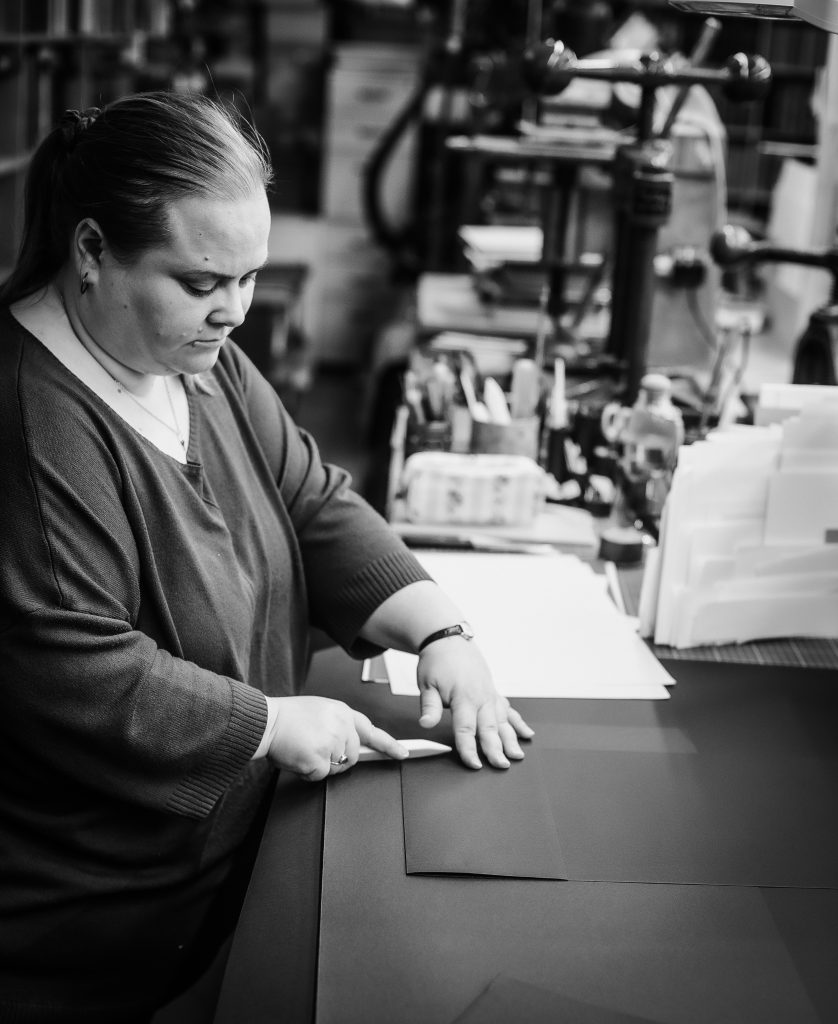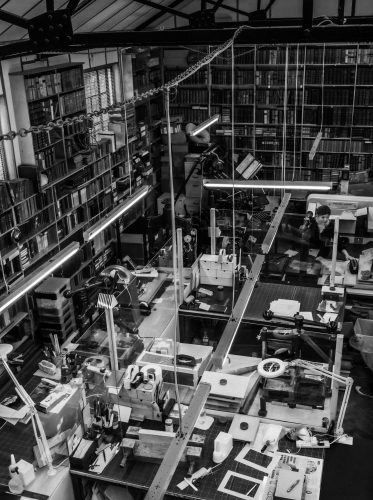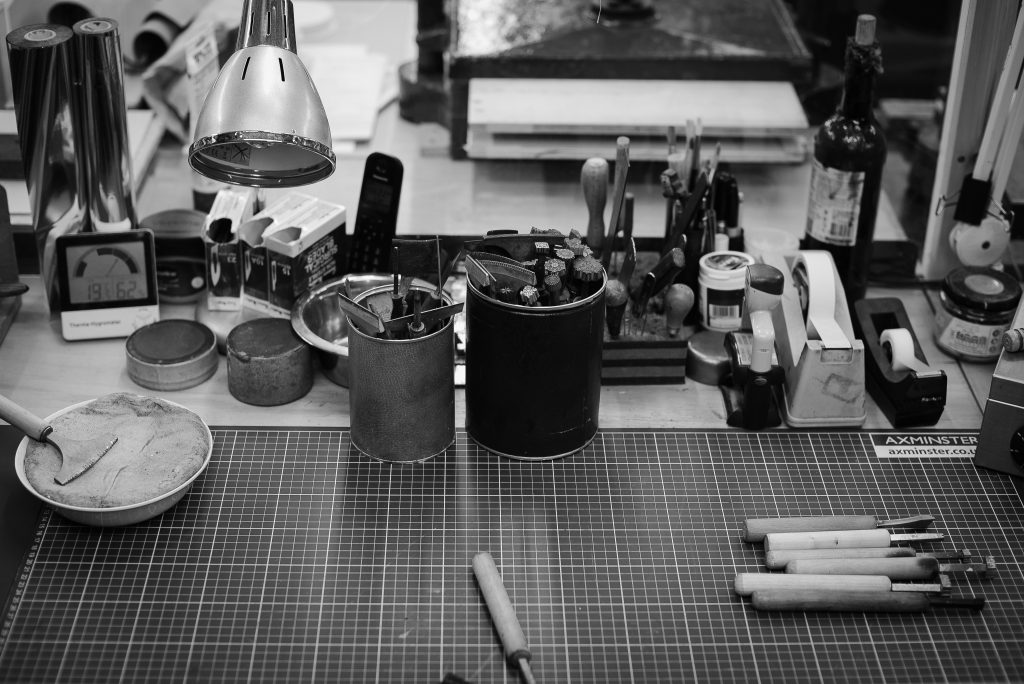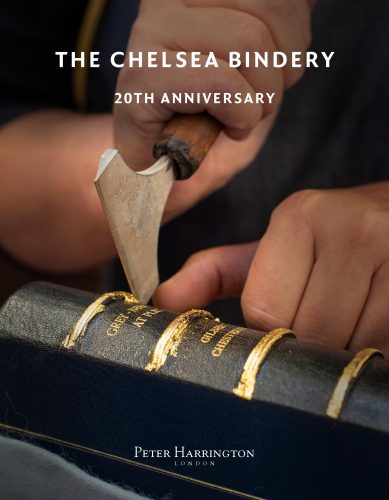Peter Harrington’s in-house bindery, The Chelsea Bindery, is one of only a handful of traditional binderies left in London. In 2020, to celebrate the 20th anniversary of the bindery’s founding, we produced a catalogue to showcase the beautiful bespoke work carried out by their expert bookbinders.
Bookbinding is a highly skilled craft, taking years to master. Many of the tools, processes, and materials used in traditional binderies have remained largely unaltered for centuries. It requires time, skill, and dedication to train as a master bookbinder, and only a few make this their chosen profession. Lauren Hepburn spoke to Jasmin and Rosemary, two bookbinders working at The Chelsea Bindery, about their roles.
How long have you worked for The Chelsea Bindery and what is your role?
Rosemary: Since 2017. I work mainly with text blocks; preparing books for binding.
Jasmin: I have been working at the Chelsea Bindery for six years, making cloth and leather boxes, which are used to house valuable books, and leather book cases – headbanding and decorating books with leather onlays. I am currently in training to do finishing (gold tooling), so that I will also be able to add decorative details to spines and covers in gold leaf.

What led you to this profession?
R: I love books and have always enjoyed making things with my hands. I took a two week bookbinding course, which led to me completing a Foundation Degree in Book Conservation.
J: My love for bookbinding started with my chance acquisition of a small Adana letterpress machine. I used it to make small artists’ books, and soon became especially interested in how books are bound. This led me to study Bookbinding and Book Restoration at the London College of Communication, and the discipline has been my passion ever since.
How long does it take to learn the skills of the craft?
R: A lifetime. I’m still learning!
J: You never really stop learning, as there are endless unique and challenging projects. It’s what makes it so interesting.
What does your typical day at the bindery look like?
R: I have quite a variety of jobs, so there is no set routine. I start with whichever task I am currently working on. That could be paper repairs, headbanding, making endpapers, onlays, sewing text blocks, and more.
J: I typically work on a number of projects at the same time, such as different boxes at various stages in the crafting process, or spokeshaving leather while waiting for glue to dry. The nature of the work I am doing depends on what needs to be finished most urgently.

What tools and materials do you work with; are they the same as would have been used historically or has technology changed the process?
R: There are a lot of tools which would have been used historically – form follows function, after all – but there are quite a few modern tools as well, such as Teflon bone folders or using the guillotine instead of a plough .
J: Things haven’t changed much! All of our work is still done by hand and we use bone folders, shears, animal glue, spring dividers, sewing frames, nipping presses, and many other traditional tools. Some key modernisations include the addition of PVA glue, and we use a Linotype machine for type casting, rather than single-letter hand tools for gold finishing. Overall, the work is still done as it has been for centuries.

Why do you think traditionally bound books continue to hold such an appeal with people?
R: People love books for many reasons, and even those who don’t generally have a fundamental respect for them. Books have been regarded as holy; mystifying in an age when few were literate; gifts; they have been bought for display, education, reference, and can be considered furniture or forms of art. When a book is decorated, beautified, it can increase its artistic, historical and monetary value.
When an evolving range of fiction became available to a literate society, more people wanted to read. The affection of a story’s readers often transfers to the books that contain them.
People cling to ideas of what constitutes a book; it took centuries for the use of papyrus to be substituted with other materials. The casual look of the codex has changed very little since it was invented. But the structure, materials and decorative styles have. Written records have been part of nearly every known culture on earth. All of today’s societies have a history full of book lovers.
J: I believe it is due to the difference between handmade and machine-manufactured books. There is a quality and individuality about handbound books; the skill and passion involved in making bespoke books speaks of human touch, and ensures that each one is distinct and special.
Roughly how many hours are spent working on each item?
R: It varies, depending on the size and the condition of the book, as well as what is required and wanted for it.
J: This is a difficult question to answer, as every job is different. The boxes that I make can vary between taking 3.5 hours and 10 hours – or more. It depends on the materials used, such as whether it is made with cloth or leather, its size, and whether other extra details are required, like padding, wells, ribbons, frames, and so on.
Where do you source materials?
J: There are still a few companies that trade in specialised bookbinding materials. We purchase our bookbinding tools, binding cloths and some leather from Ratchford Ltd and Hewit & Sons Ltd; the leather we use to cover the books and boxes is mainly supplied by Harmatan and Oakridge Leathers 2008 Ltd; some binding cloths are sourced from Winter & Company; millboard and paper come from John Purcell Paper.
The Chelsea Bindery – 20th Anniversary
Our anniversary catalogue features first, limited, and
special illustrated editions, showcasing the Chelsea Bindery’s mastery of artisanal techniques, with each binding complementing the book it encases.






